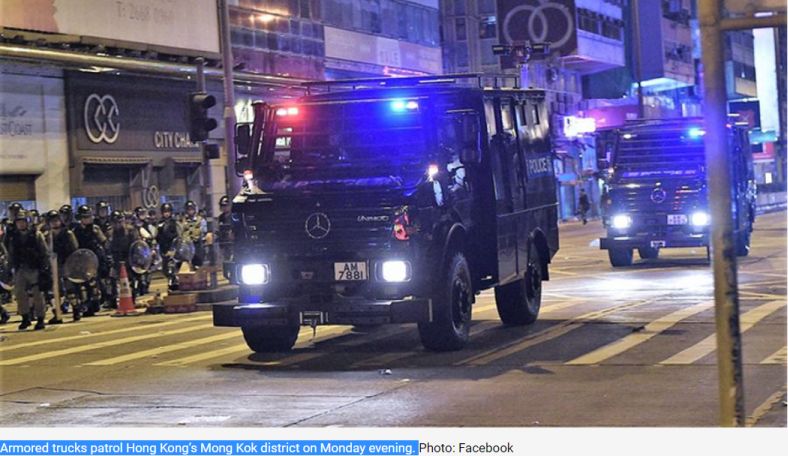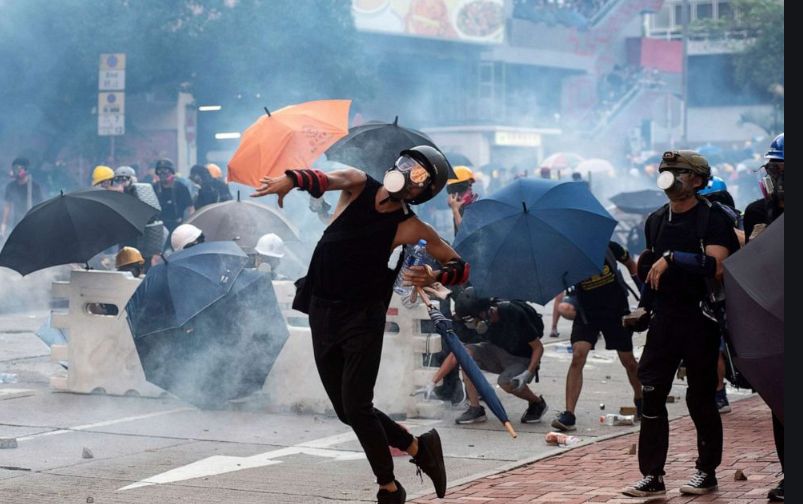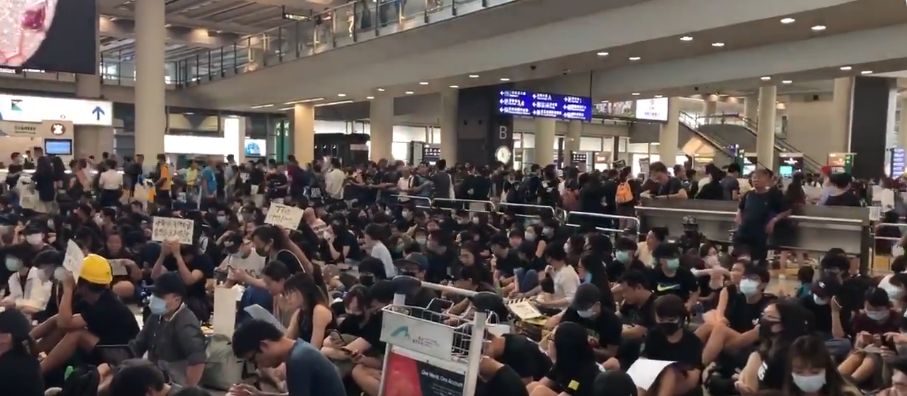By Eric Vandenbroeck and co-workers 8 August 2019
Yesterday Wednesday 7
August lawyers marched through Hong Kong whereby two days earlier, on Monday,
HK police revealed armored trucks to fight protests; Bulletproof vehicles,
sound, and water cannons will be deployed in future Hong Kong demonstrations.

Yesterday
around 3,000 legal lawyers demonstrated in Hong Kong to pile pressure on
the justice department in the ninth week of protests. Dressed in black, more
than 3,000 lawyers on Wednesday (Aug 7) marched from the Court of Final Appeal
to Justice Place shortly before 1pm, making this the sixth and largest silent
protest of its kind staged by the legal community since Hong Kong was handed
back to China by Britain in 1997.

During these nine
weeks, Hong Kong protesters have drawn the world’s attention to the fragile
state of play in this Special Administrative Region of China. As many as 2
million people, out of a population of 7.5 million, have poured into the
streets, protesting the erosion of their special status. And next, three days
of demonstrations are planned at the airport.
The city's
pro-Beijing government is pushing a bill through the legislature that would
allow extraditions to any jurisdiction with which it doesn't already have a
treaty, including mainland China for the first time. The proposal has sparked
some of the biggest protests the city has seen in recent years as well as
criticism from influential legal groups, business associations, and western
diplomats.
This week has seen
escalating criticism from the city's influential legal communities, including
the Law Society -- which published a detailed critique of the proposals, adding
to opposition already voiced by the Bar Association and multiple chambers of commerce.
Critics fear the law if passed, will entangle people in China's opaque and
politicized court system.
Former Bar
Association chairman Alan Leong urged authorities to act to save Hong Kong.
“Because our system is deteriorating at a speed that is totally unacceptable.
Unless we do something to regain the trust and confidence of not only Hong
Kong, but also of the international community, in the Hong Kong legal system,
we are doomed,” he said.
The lawyers also said
they fear that the justice department’s prosecutions of arrested protesters are
taking an increasingly political slant after 44 protesters were charged with
rioting, an offense that carries a 10-year jail term.
“We see there has
been selective prosecution,” said a 29-year-old litigator who would only give
her name as JL. Referring to attacks on demonstrators by suspected triads, she
said: “The [lack of prosecutions over the] white
shirt attack in Yuen Long, compared to the speed of charging so-called
rioters, there’s a difference in how police handle the case.”

The question now is will China crush the protests in
Hong Kong?
China warned Tuesday
that it will be “only
a matter of time” before it punishes those behind two months of
pro-democracy protests in Hong Kong that have increasingly devolved into
violent clashes with law enforcement. Will China crush the protests in Hong
Kong?
Speculation has grown
that the Communist Party-led central government will deploy the military to
quell demonstrators after Chinese officials pointed to an article in Hong Kong
law that allows troops already stationed in the city to help with “public order
maintenance” at the Hong Kong government’s request.
In a video
posted by the Global Times of police drills in Shenzhen, the mainland city bordering
Hong Kong, dozens of police were seen taking on a group of protesters dressed
similarly to the Hong Kong demonstrators.

But Chinese
authorities already have a tool
kit, honed during the 2014 protests known as the Umbrella Movement, to keep
Hong Kong in check. Rather than cracking down with its military, the
mainland authorities are likely to step up other repressive measures to end the
protests and restore comprehensive control without undermining an arrangement
that serves them well. Beijing, in other words, doesn’t need to turn to what
commentators call the “nuclear option”: it hopes to achieve what it wants at
lower costs with tools it has used before.
Also as indicated
above, the police are credibly suspected of colluding with triads, members of
Hong Kong’s organized criminal underworld. In a July 21 incident, hundreds of
suspected triads dressed in white shirts indiscriminately beat locals with
wooden sticks and metal rods at the Yuen Long train station. The police did not
show up until after the gangsters had left, and senior officers were filmed
speaking with the men in white shirts prior to the attack. Suspected protesters
(including a nurse who volunteered emergency first aid) have been charged with
rioting, which carries a maximum prison sentence of ten years, yet the
gangsters have merely been investigated for unlawful assembly, a much less
serious crime. Hong Kong police said they arrested 568 demonstrators aged 13-76
since June.
So far, verbal
threats and physical abuse have only stiffened the resolve of Hong Kong’s
people to defend the freedoms they have grown up with. Various professional and
community groups, including accountants, architects, civil servants, finance
workers, flight attendants, and medical workers, have organized one
demonstration after another. Waves of arrests have inspired protesters to
surround police stations and courthouses. In the last two weeks, the
confrontations between protesters and the police have spread from Hong Kong
Island to residential and shopping areas across the territory.
There is some chance
that the police and the triads can end the current cycle of protests by
arresting, jailing, and roughing up enough people. However, the people of Hong
Kong are turning to other protest methods, such as a general strike, boycotts
against pro-Beijing businesses, and targeted support for pro-democracy
entities, that are less vulnerable to police and triad brutality. Most of all,
indiscriminate and illegitimate coercion has backfired by creating public
outrage against Beijing.
Whereby normalizing
police and gangster violence, China has exposed the lie behind “one country,
two systems” and its principle of “Hong Kong people ruling Hong Kong.” The
message that the “radical” protesters, at the high price of police beatings and
heavy jail terms, want to send to Beijing is that “if we burn, you burn with
us.” Beijing is still unlikely to send in troops. But if it is looking for an
excuse to declare an emergency, it will have one, but one that is of its own
making.
Australia
on Wednesday joined Ireland,
the UK, and Japan in
issuing Hong Kong travel warnings. More than 5 million people visited Hong Kong
in June this year, of which roughly 80% were from mainland China. Still, there
are varying reports about whether tourism has been affected by the protests.
Police said they
arrested 148 people in connection with Monday’s protests, and another nine on
Tuesday night. A total of 589 people have been arrested in connection to the
protests in the past two months.
During an earlier 79-day
round of protests in 2014 demanding direct elections for Hong Kong’s chief
executive, police announced around 1,000 arrests. Eight leaders of the 2014
movement were sentenced this year to up to 16 months in prison on charges of
public nuisance offenses, in what critics called an apparent effort to
intimidate other activists.
As the government has
refused to budge on protester demands, Chinese state-run media has ramped up
its rhetoric against the demonstrators. It only worsened after Hong Kong
protesters twice threw the Chinese national flag into Victoria Harbor in the
major shopping district of Tsim Sha Tsui, provoking fury on the mainland.
In an editorial
Monday, state-run
news agency Xinhua said “the bottom line of ‘One Country, Two Systems’
brooks no challenge,” referring to the special legal structure under which Hong
Kong is governed. Xinhua said throwing the flag into Victoria Harbor was “an
unforgivable, lawless act that has blatantly offended the national dignity, is
an insult to all Chinese people.”
But Hong Kong is not
Tiananmen Square, and 2019 is not 1989. Putting these protests down with the
army would not reinforce China’s stability and prosperity. It would jeopardise them.
The latest protest in
Hong Kong is a laser show at the space museum, intended as a rebuke to police
after a student got arrested for carrying laser pointers last night.
But if Beijing is not bluffing
If Beijing is not
bluffing, however, and does eventually intervene, it would do so cautiously.
Rather than risk another Tiananmen Square-style incident by sending in the
People's Liberation Army, Beijing would probably rely on the People's Armed
Police, which is better equipped to defuse protests and riots without causing a
bloodbath. Hong Kong's Basic Law doesn't provide for the entry of mainland
forces other than the People's Liberation Army (and then only upon the request
of Hong Kong's chief executive). Beijing might instead cite Article 18 of the
basic law, which permits the National People's Congress to impose a curfew if
the Hong Kong government cannot restore order, arguing that the right to impose
a curfew implies the right to police a curfew. If it did, however, local police
would probably be in command of any People's Armed Police forces.
More protests and
civil unrest are set to rock Hong Kong, starting on Friday at Hong Kong
International Airport with a rally expected to last three days.
According to
information widely circulated online Wednesday, protest organizers have called
for a “tourist reception by 10,000 protesters” at the Arrival Hall in Terminal
1 at the airport starting from 1pm on Friday.
Update 9
August:
The crowd at the
airport, early this afternoon appeared to number in the high hundreds, included
many older Hong Kongers, in contrast to the young
people who have been at the forefront of recent street battles with police.
Protesters held signs in English and Chinese and had printed leaflets in
multiple different languages explaining the causes and demands of the demonstrations
for arriving tourists.


Multiple additional
protests are planned for this weekend, including in the northern New
Territories town of Tai Po and in Sham Shui Po, in Kowloon, where police fired
tear gas in clashes with protesters earlier this week. As of Friday afternoon,
police had refused to issue letters of no objection for the planned protests on
Saturday and Sunday respectively, meaning they could be deemed illegal
assemblies. Protesters are appealing those decisions.
For updates click homepage here